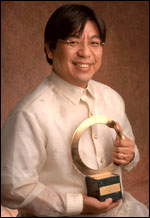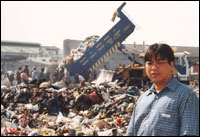The industrialized world is fond of exporting its problems: its toxic waste, its low-paying jobs, its most incorrigible mining and logging companies. Von Hernandez, the coordinator of Greenpeace International’s Toxics Campaign in Asia, says “dirty technology” — especially large-scale waste incineration — is also being shipped away to developing countries. On April 14, Hernandez was awarded one of six 2003 Goldman Environmental Prizes for his battle against waste incineration in the Philippines.

Von Hernandez.
Photo: Goldman Environmental Prize.
Hernandez, 36, a native of Manila and a former literature professor at the University of the Philippines, has spent nearly a decade fighting a slew of proposed waste incinerators in his home country. In the mid-1990s, he and others organized a nationwide public education program, informing communities about the dioxins, heavy metals, and other toxic compounds released by waste incineration. The program also enlisted supporters ranging from congressional spouses to the Catholic Church. Thanks to this concerted campaign, the Philippines became the first country in the world to adopt a nationwide ban on incineration.
Hernandez is now working to make sure the incineration ban is enforced, and battling new proposals for giant landfills — not an easy task when most incinerator and landfill projects are backed by powerful multinational corporations. He’s also pushing for implementation of the 2001 Ecological Solid Waste Management Act, a Philippine law that requires local governments to invest in alternative waste-disposal programs.
“Waste doesn’t really require a technological solution,” he says. “The solutions lie more in education, in organizing the community to do waste segregation and recycling and composting.” To further his cause, Hernandez has even stolen mayors’ garbage and exposed the sad state of their plastic and glass segregation. Hernandez spoke to Grist from his home in Quezon City.
How did you become an environmental activist?
In 1991, in Ormoc City [on the island of Leyte in the central Philippines], there was a flash flood and landslide that claimed thousands of lives. At the time, I was doing some volunteer work for an NGO [non-governmental organization] that delivers health services, and we went to the site of the disaster and did some rehabilitation work. That was really shocking to me. It opened my eyes to the fact that the environment really is a survival issue — literally, in that case. I got involved with a group called the Green Coalition, which was the local partner of Greenpeace. In 1995, I was hired as the toxics campaigner for Greenpeace. Greenpeace had no office in all of Asia at that time, so I was basically operating alone without an office or any infrastructure.
When did you first realize that waste incineration was a problem in the Philippines and other Asian countries?
When I joined the Greenpeace toxics campaign, I was doing a lot of research on the hazardous-waste trade. I found that all kinds of things were being sent to the global South under the guise of recycling and economic recovery, and I found that a lot of dirty technology was moving our way, too.
In the mid-90s, there were no new incinerators being built in the United States, and it was also becoming controversial in Europe. There were at least 10 proposals for municipal incinerators in the Philippines. Jancom [a waste-management consortium based in Australia] wanted to build a facility in Manila that would have burned 4,500 tons a day. It would have been the biggest incinerator in the world if it had been built.
Manila generates 6,000 tons of waste per day — that’s an official figure — so [city officials] thought the incinerator would extend the life of the landfill. The people in these communities often think incineration is a good thing: The proponents come to them with a magic wand, and say they’re going to build the facility for free and solve all their problems.
So we organized a coalition, and we took advantage of a political opening provided by the Clean Air Act that was then pending in Congress. Through our allies in Congress, we were able to put in a provision that, in 1999, became a nationwide ban on incineration.
In 1998, you helped organize mass protests against incineration. What do you think inspired people to take to the streets?
One of the reasons we insisted that incineration be included in the Clean Air Act was that the government has no capacity to regulate the emissions [from incinerators]. I think the people understood that. They realized that the power to give permission must be matched with the power to protect people from emissions. It was a health issue, first and foremost, but it also became an economic issue. Local governments, when they realized how much they were going to pay to operate the incinerators, realized they could go bankrupt. It also became a corruption issue, because we exposed anomalies in Jancom’s business practices.

Hernandez at an illegal dump north of Manila.
Photo: Jimmy Domingo, Greenpeace.
You’ve worked with activists around the world. What unique challenges does an environmental activist face in the Philippines?
I’ve worked with waste activists in other developing countries, and I think we’re confronted with many of the same problems. Decisions are constantly made behind closed doors, and the communities are always the last to know. In the Philippines, we do have a very strong tradition of taking direct action. We toppled the dictator [Ferdinand] Marcos through the People Power revolution, and we did it again in 2001 when we deposed [President Joseph] Estrada.
Of course, we find that this is not really enough. You change the faces, but the system is still very corrupt. So our campaign is also a campaign to make democracy work, to expose the machinations of the bureaucracy, to expose who benefits. We think this [campaign] can be a real cleansing process, both literally and figuratively.
It seems that many environmental restrictions in the U.S. have a dark side — that they encourage polluters to move to other countries. What can U.S. activists do to help reverse this trend?
There are some things that can only be stopped from the U.S. side. For example, obsolete U.S. Navy ships are sent to India for destruction. India is interested in the steel, but they also get the poisons. If you visit the ship-breaking yards in India, they’re like hell on earth. One person dies every day there. The Basel Convention prohibits this practice, but the U.S. has refused to ratify the convention. [Editor’s note: The convention bans the exporting of hazardous wastes from industrialized countries to developing countries. The other two holdouts to the convention are Afghanistan and Haiti.] I know of some U.S. groups, not many, that are campaigning for the U.S. to stop exporting this kind of hazardous waste.
How do you keep yourself going?
Constantly there are challenges, like right now we’re facing a mega-landfill proposal. The other week I was at a dump site where there was rampant open burning, and the community was completely covered with black smoke. That really angers me, and that anger gives me the drive to keep going. By constantly connecting with people, I’m able to sustain that anger. Hopefully we’ll see some improvements soon and I’ll be less hypertensive.

How do you think this award might change your work?
It gives our campaign a boost, gives us validation that we are doing the right thing. Many congressmen, many politicians make fun of our work, talk about how stupid the country was to be the first to ban waste incineration. The award gives us recognition; it tells us we’re on the right track. It’s also an affirmation for communities fighting incineration in other places.
How do you plan to use the money?
Two weeks ago, I was at this huge dump site [in Manila] called Smoky Mountain — it’s closed now, but it’s still an icon of poverty in the Philippines — and there’s this priest there who has organized a small part of the community to begin segregating waste, to recycle. They have a craft center, where they make crafts from the trash they find, and they have a small garden. So amid this poverty and squalor, in this really dirty environment, there is a garden. I’d like to support programs like that.


